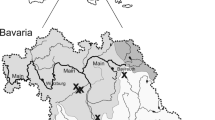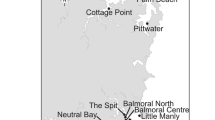Abstract
Over the past decade, four exotic tunicates (Styela clava, Ciona intestinalis, Botrylloides violaceus and Botryllus schlosseri) have been reported in the Brudenell estuary in Prince Edward Island (PEI), Canada. Styela clava was the first exotic tunicate to arrive in 1997, rapidly establishing, spreading, invading, and eventually becoming a nuisance in several estuaries of PEI. In the Brudenell estuary, S. clava remained the only exotic nuisance tunicate until 2003. In the fall of 2004, the vase tunicate C. intestinalis, was reported in low abundance, followed by the two colonial species, B. schlosseri and B. violaceus, reported in the spring of 2005. The abundance of C. intestinalis rapidly increased post-introduction, eventually replacing S. clava as the foremost nuisance species on mussel farms in the estuary. To date, C. intestinalis continues to colonize this estuary at epidemic proportions, resulting in the continuing drop of S. clava abundance. The current abundance of C. intestinalis is estimated at 5 cm−2, which is similar to S. clava abundance at its height in 2003. The 2006 abundance of S. clava is estimated to have fallen to near 0 cm−2. The dominance of C. intestinalis as a fouling organism on mussel farms is considered a serious threat to this aquaculture industry, mainly due to its unmanageable weight. The process of the detection, establishment, invasiveness, and eventual rise to nuisance level of exotic tunicates in the Brudenell River is presented.



Similar content being viewed by others
References
Binggeli P (1994) Misuse of terminology and anthropomorphic concepts in the description of introduced species. Bull Br Ecol Soc 25:10–13
Bourque D, Davidson J, MacNair NG, Arsenault G, Leblanc AR, Landry T, Miron G (2007) Reproduction and early life history of an invasive ascidian Styela clava Herdman in Prince Edward Island, Canada. J Exp Mar Biol Ecol 342:78–84
Buizer DAG (1980) Explosive development of Styela clava Herdman, 1882, in the Netherlands after its introduction (Tunicata Ascisiacea). Bull Zool Mus Univ Amst 7:181–185
Carlton JT, Geller JB (1993) Ecological roulette: the global transport of nonindigenous marine organisms. Sci 261:78–82
Carver CE, Chisholm A, Mallet AL (2003) Strategies to mitigate the impact of Ciona intestinalis (L.) biofouling on shellfish production. J Shellfish Res 22:621–631
Davis MA, Grime JP, Thompson K (2000) Fluctuating resources in plant communities: a general theory of invasibility. J Ecol 88:528–534
Department of Fisheries and Oceans (2005) Shellfish monitoring network. In: Fisheries and oceans Canada, Gulf Region. https://www.glf.dfo-mpo.gc.ca/sci-sci/smn-rmm/index-e.jsp. Cited 9 May 2007
Department of Fisheries and Oceans (2006) An economic analysis of the mussel industry in Prince Edward Island. Moncton, New Brunswick, Policy and Economics Branch, Gulf Region, Department of Fisheries and Oceans
Hunt HL, Scheibling RE (1997) Role of early post settlement mortality in recruitment of benthic invertebrates. Mar Ecol Prog Ser 155:269–301
Lambert CC, Lambert G (1998) Non-indigenous ascidians in southern California harbors and marinas. Mar Biol 130:675–688
Locke A, Hanson JM, Ellis KM, Thompson J, Rochette R (2007) Invasion of the southern Gulf of St. Lawrence by the clubbed tunicate (Styela clava Herdman): potential mechanisms for invasions of Prince Edward Island estuaries. J Exp Mar Ecol Biol 342:69–77
Lützen J (1999) Styela clava Herdman (Urochordata, Ascidiacea), a successful immigrant to North West Europe: ecology, propogation and chronology of spread. Helgoländer Meeresunters 52:383–391
MacNair N (2005) Invasive tunicates of concern for Prince Edward Island aquaculture. Charlottetown, Aqua Info Aquaculture Note. PEI Dept Agri Fish Aqua
Millar RH (1952) The annual growth and reproductive cycle in four ascidians. J Mar Biol Ass UK 31:41–61
Minchin D, Duggan CB (1988) The distribution of the exotic ascidian, Styela clava Herdman, in Cork Harbour. Ir Nat J 22:388–393
Osman RW, Whitlatch RB (1995a) The influence of resident adults on larval settlement—experiments with 4 species of ascidians. J Exp Mar Biol Ecol 190:199–220
Osman RW, Whitlatch RB (1995b) The influence of resident adults on recruitment: a comparison to settlement. J Exp Mar Biol Ecol 190:169–198
Ramsay A, Davidson J, Bourque D, Stryhn H (submitted) Reproduction, early life history and seasonal development of the invasive ascidian Ciona intestinalis in Prince Edward Island, Canada. Aquat Invasions
Stachowicz JJ, Whitlatch RB, Osman RW (1999) Species diversity and invasion resistance in a marine ecosystem. Sci 286:1577–1579
Thompson B, MacNair N (2004) An overview of the clubbed tunicate (Styela clava) in Prince Edward Island. PEI Agric Fish Aqua Tech Rep 234:viii + 29 pp
Acknowledgements
This study was supported by the Department of Fisheries and Oceans through the Aquaculture Collaborative Research Development Program. We thank Jonathan Hill, Vanessa Lutz-Collins, John Davidson, John Fortier, Kim Swan, and Allan Morrison for assistance with sample collection and laboratory analysis.
Author information
Authors and Affiliations
Corresponding author
Rights and permissions
About this article
Cite this article
Ramsay, A., Davidson, J., Landry, T. et al. Process of invasiveness among exotic tunicates in Prince Edward Island, Canada. Biol Invasions 10, 1311–1316 (2008). https://doi.org/10.1007/s10530-007-9205-y
Received:
Accepted:
Published:
Issue Date:
DOI: https://doi.org/10.1007/s10530-007-9205-y




